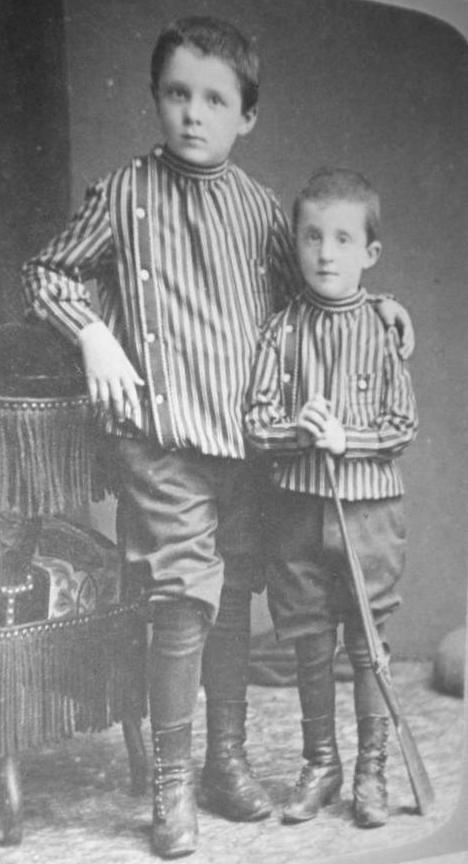
French Shirts and Shirt-like Garments: Chronology

Figure 1.-- This French CDV portait shows two unidentified boys wearing matching striped blouses with bloomer knickers and long stockings. The side-buttoning blouses are done rather like Russian blouse tunics. The CDV is ubdated, but looks like the 1870s to us. The studio was L. Delaporte in Melun, a neighborhood of Paris.
|
|
We have just begun gto build our chronology of French short like-pgarments. We ahve no infotmation agt this gtime on the early-19th century. Only with the advent of photography do we begin to see waht kinf of shirt-like garments French boys were wearing. Commercial photography was invented in France by Louis Daguerre (1839). Unfortunately we do not see many examples of French Daguerrotypes (1840s-50s). Thus makes it difficult to assess French trends at mid-century. We do have a lot of Americans Dags and Ambros from this period. And we see a lot of boys wearing long-sleeved blouses without jackets. Whether this trend was also common in France we do not know. We note some fashions were shared in the major European countries and America. This is somthing we are just beginning to assess. Only with the CDV do we begin to see large numbers of images in France and other European countries (1860s). Only many of the boys in the formal studio portait of the day are wearing jackers, making it sufficult ti see the shirts and blouses which they are wearing underneath. his is especially true because collar-buttoning suit jackets were popular for boys. We are beginning to acquire some images. We note some boys wearing blouses. We note some that lokk to be dome like tucked in tunic. We note bothers wearing striped tunic-look blouses (1870s). French boys began wearing smocks to school (1870s). This further complicates our assessment. Unlike Italian boys, French boys generally wore their shirt collars under ther smocks. We believe at this time that French shirts and blouses were similatr to those in America and Britain. We note Fauntlroy blouses (1880s and 90s). They wee not as elaborate or as popular as in America, but we do see them. We also see Eton collar, but these were mostly detachable collars, not Eton blouses. And they wee not ascommon as in Britain. After World War I we begin to see younger boys wearing fancy blouses, some with short slleves and even puffed slaeave bloss. This continued into the 1950s after World War II.
HBC

Navigate the Boys' Historical Clothing Web Site:
[Return to the Main French shirt page]
[Return to the Main French garment page]
[Introduction]
[Activities]
[Biographies]
[Chronology]
[Clothing styles]
[Countries]
[Bibliographies]
[Contributions]
[FAQs]
[Glossaries]
[Images]
[Links]
[Registration]
[Tools]
[Boys' Clothing Home]
Created: 3:47 AM 12/23/2013
Last updated: 3:47 AM 12/23/2013



